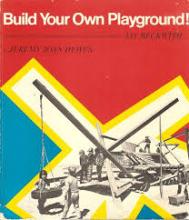
Build Your Own Playground! A Sourcebook of Play Sculptures, Designs, and Concepts from the Work of Jay Beckwith contains planning and building details for creative playgrounds built from unorthodox materials with community volunteers. The book was written by Jeremy Joan Hewes with Jay Beckwith and published by Houghton Mifflin Company in 1975.
Designer Jay Beckwith had helped develop more than fifty community and school playgrounds that relied on the concept of community-built playgrounds. Involving parents and children in the design process of the playground-built ownership, and the value of the playground increased in proportion to their involvement in its creation. As one of the pioneers of community-built playgrounds, his playgrounds were usually made of wood, and the structures were often large frameworks of interconnected platforms, ramps, tunnels, bridges, and ladders. Because the structures were primarily built by unskilled community volunteers, the designs needed to be fairly easy to construct.
Chapter 1 – What Do Kids Need? explains the design considerations that should be addressed before the building of a playground can be done. Safety issues in the book describe the hard surfaces under playgrounds that were prevalent at the time before playground surfacing became regulated. Relative safety could be designed into the playground with thoughtful planning, and the importance of risk taking for children is included in the discussion. Chapter 1 also describes the characteristics of children’s play that are important for the design of the playground. Social interaction, physical development, and cognitive growth are all affected by play and should be built into the play environment. The book gives specific suggestions for integrating these needs into the playground.
Chapter 2 – Can We Do It? gives practical suggestions for the initial planning stages of the community-built playground. Choosing the site for the playground may require working with a possible city government or private owner, and securing jurisdiction over the site may take some negotiation. Raising the funds for the playground build may involve federal, state, and local funds as well as private donations or fundraisers. Ideas for obtaining materials necessary for the build include scrounging materials that may be inexpensively obtained. The chapter continues with suggestions for the planning of the design for the playground. Helpful suggestions for bringing ideas to the group and getting consensus within the group are given. Organization of the building process by the community volunteers and children who have been involved in the design of the playground is given.
Chapter 3 – What’s So Special Here? describes the attitude changes that result in a community-built playground. Vandalism has proven to be a lesser problem when children are involved in the build. Members of the community tend to be more engaged with the playground as well as recognizing that by working together they could accomplish change and tackle other issues as well.
Chapter 4 – What Kind of Structure Do We Want? contains the “nuts-and-bolts” part of the book. This chapter shows examples of possible design elements using wood and logs. Types of wood framing such as the H-frame, A-frame, W-frame, and X-frame are described with suggestions for joints and braces. The organization of the structure also needs to be considered to offer a variety of play experiences for the children. Lineal progression, loop, spiral, and overlapping designs all add different dimensions to the design. A play environment can also be designed around a theme.
Chapter 5 – What Play Experiences Should We Have? suggests the types of play that should be included in the playground design. The three principal types of play are active, climbing, and quiet play. Active play elements include slides, swings, fire poles, turning bars, balance beams, ramps, and ladders. Climbing can be provided with wooden and metal structures made for climbing as well as including trees and large rocks for a natural climbing experience. Ropes, chains, cargo nets, and tires can all produce flexible structures for climbing. Equipment for quiet play can be private spaces designed into the play structure as well as offering sand and water play, outdoor meeting places, stages, gazebos, and arts and crafts tables. Some nonequipment features such as loose parts and tricycles and the outdoor storage to secure them add significantly to the play value of the playground.
Chapter 6 – How Does It All Go Together? pulls together the designs of the community to define the general goals and activities of the environment. Committees within the community group are created for the three main areas of responsibility: design, materials, and communications. A community coordinator is selected to be the leader of the project. To aid these processes, the chapter includes a sample questionnaire to inventory the community’s interests, an inventory of basic needs for use by the design committee, a list of considerations for playground design, a list of materials that can be found for free or inexpensively, and some considerations for writing a contract between the community, a consultant, and the owner of the site.
Chapter 7 – “Where’s My Hammer?” describes the basic guidelines for the actual playground build. The logistics of the construction should involve careful planning for a smooth building operation. Procedures for the proper use of tools must be determined as well as the division of labor by the volunteers. A crew foreman with experience in tool use and safety must be available to divide the workers into teams and keep them working steadily while instructing them in safe construction practices. Specific techniques in using tools and working with concrete are given in the book with accompanying pictures.
Chapter 8 – Okay, Now What? addresses play environments that include designs for children with special needs as well as special projects that include art, film, drama, gardens, and green schoolyards. The final thoughts include adult play as well as environments for zoo play.1
- 1. Hewes, Jeremy Joan. “Build Your Own Playground! A Sourcebook of Play Sculptures, Designs & Concepts from the Work of Jay Beckwith. Boston, MA: Houghton Mifflin Company. 1975.

